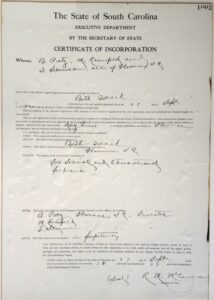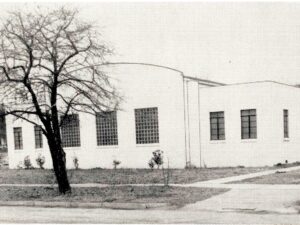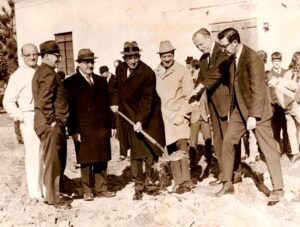Beth Israel Congregation has a very long and rich history. As the city of Florence grew, so did the Jewish population. On October 26, 1887, a charter application was made for a charitable and religious organization to be known as the Florence Hebrew Benevolent Association. The following were the two objectives taken from their Constitution and By-laws in 1887:
- “To unite the Hebrews of Florence and surrounding country into a fraternal and benevolent association and to assist needy Israelites.”
- “To purchase and maintain a suitable burying ground for members.”
The organization carried out their mission by aiding and assisting its members in sickness and distress and purchasing a suitable burying ground from the Northeast Railroad for $50.
-

Certificate of Incorporation The Jewish population was growing and as more children blessed the community, the need for religious education was apparent. The beginning of the Religious School was on June 2, 1889.
- A Certificate of Incorporation was filed with the state of South Carolina on September 27, 1912, establishing Beth Israel Congregation.
- In 1922, a compromise was reached between the Orthodox Jews of Florence and those who chose to follow Reform Judaism. The decision was made to hold Reform services and Religious School classes monthly, and Orthodox High Holy Day services. Rabbi Raisin of Kahol Kadosh Beth Elohim was hired to conduct the Reform services and remained part time spiritual leader for 25 years.
- Around 1927, the decision was made to build a sanctuary. Prior to World War II, reform services were held at the YMCA, then moved to the Masonic Temple after World War II. In 1947, the YMCA again became home for Reform Services.
-

Beth Israel in 1949 In February of 1949, a meeting was held to discuss the construction of a new religious facility on land located on Park Avenue, which was donated by Dr. Michael M. Morse. The Union of American Hebrew Congregations provided the building plans and the facility was completed in July 1949. This is the current home of Beth Israel Congregation.
- In 1953, Rabbi Tibor Fabian came to serve as the first full-time rabbi. Rabbi Fabian helped to organize the Sunday School and began conducting weekly services on Friday nights. Rabbi Morris Clarke followed and introduced music to the congregation. Rabbi Avery Grossfield came next and introduced Hebrew to the Religious School and held adult education classes.В He performed the first Bar Mitzvah service at Beth Israel.
- The next spiritual leader was Rabbi Gottesman, a circuit riding rabbi who served until 1961 when Rabbi Charles B. Lesser was hired as a fulltime rabbi. Rabbi Lesser remained until 1970.В During his tenure,

Social Hall Groundbreaking 1969 plans were made to remodel the temple, add a kitchen, classrooms and a social hall which were all completed in June 1970.
- By this time, Rabbi Howard Folb was hired, the building was finished and opened for use during the High Holy Days with Rabbi Folb officiating. After eleven years, Rabbi Folb left and was replaced by Rabbi Sidney Strome. Next, Rabbi Lawrence Mahrer served for ten years. The sanctuary was renovated and the pulpit was remodeled during this time. Rabbi Marc Kline served from 1996 until 2003. Following Rabbi Kline, Beth Israel was served by a student rabbi, Malcolm Cohen; then Rabbi Alvin Sugarman, who each served part-time for one year; Rabbi Jeffrey Ronald (2005-11); and then Rabbi Aaron Sherman (2011-25) & Rabbi Leah Doberne-Schor (2012-23), who served as co-part-time rabbis. In 2025, the congregation hired Rabbi Lauren S. Cohn as their first full-time rabbi in 14 years.
- During these years of growth and expansion, two organizations became an integral part of Temple life: Beth Israel Sisterhood and Beth Israel Men’s Club. Both groups became affiliated with the National Federation of Brotherhoods and National Federation of Sisterhoods. In 1973, the decision was made to merge the two organization and The Affiliates was born. Beth Israel Congregation was a pioneer in the field of merging Sisterhood and Brotherhood, with men and women who alternated the presidency from male to female.
- During more recent years, there have been two significant mergers. First, the Darlington Congregation, whose membership was declining and they decided to merge with Beth Israel. Then, in the year 2000, the Dillon Congregation, Ohav Shalom, merged with Beth Israel.
- Beth Israel Congregation has come a long way since 1887. Today it draws from Florence, Darlington, Marion, Latta, Dillon, Kingstree and Murrells Inlet, all in South Carolina, and Laurinburg, North Carolina. The religious school is turning out young people with a more rounded Jewish education. A choir enhances services. This full-service house of worship has become the center for Judaism in the Pee Dee.
